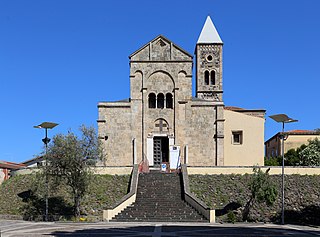Saints Justa, Justina and Henedina (or Aenidina) of Cagliari (Sardinian : Justa, Justina et Enedina, Italian : Giusta, Giustina ed Enedina) (died 130) were Christian martyrs (possibly sisters) of Sardinia, put to death at Cagliari or possibly Sassari.
Their feast day is 14 May.
The town of Santa Giusta in Sardinia is named after Justa, and the cathedral is dedicated to her.

Oristano ) is an Italian city and comune (municipality), the capital of the Province of Oristano in the central-western part of the island of Sardinia. It is located on the northern part of the Campidano plain. It was established as the provincial capital on 16 July 1974. As of December 2017, the city had 31,671 inhabitants.

The province of Oristano is a province in the autonomous island region of Sardinia, Italy. Its capital is the city of Oristano. There are 87 comuni in the province.

Justas Vincas Paleckis is a Lithuanian ex-communist and politician, signatory of the Act of the Re-Establishment of the State of Lithuania, and Member of the European Parliament for the Social Democratic Party of Lithuania.

May 13 - Eastern Orthodox Church calendar - May 15
Ludovico Baille

Tharros was an ancient city and former bishopric on the west coast of Sardinia, Italy.
Justina is an anglicised versions of the Latin name Iustina, feminine of Iustinus, a derivative of Iustus, meaning fair or just. For the masculine version of the name, see Justin.

Marrubiu is a comune (municipality) in the Province of Oristano in the Italian region Sardinia, located about 70 kilometres (43 mi) northwest of Cagliari and about 15 kilometres (9 mi) south of Oristano.

Morgongiori is a comune (municipality) in the Province of Oristano in the Italian region Sardinia, located about 70 kilometres (43 mi) northwest of Cagliari and about 25 kilometres (16 mi) southeast of Oristano on the southern slopes of Monte Arci.

Palmas Arborea is a comune (municipality) in the Province of Oristano in the Italian region Sardinia, located about 80 kilometres (50 mi) northwest of Cagliari and about 6 kilometres (4 mi) southeast of Oristano. As of 31 December 2004, it had a population of 1,366 and an area of 39.3 square kilometres (15.2 sq mi).
Pau is a commune in the Province of Oristano in the region of Sardinia, Italy, located about 70 kilometres (43 mi) northwest of Cagliari and about 20 kilometres (12 mi) southeast of Oristano. As of 31 December 2004, it had a population of 330 and an area of 14.1 square kilometres (5.4 sq mi).

Santa Giusta is a comune (municipality) in the Province of Oristano in the Italian region of Sardinia, located about 90 kilometres northwest of Cagliari and about 3 km (2 mi) southeast of Oristano in the Campidano area.

Saints Cyprian and Justina are honored in the Catholic Church, Eastern Orthodox Church and Oriental Orthodoxy as Christians of Antioch, who in 304, during the Diocletianic Persecution, suffered martyrdom at Nicomedia on September 26. According to Roman Catholic sources, no Bishop of Antioch bore the name of Cyprian.
Justa may refer to:

Neapolis was an ancient city of Sardinia founded by the Carthaginians in the sixth century BC, and apparently one of its most important places. It was situated on the west coast, at the southern end of the Gulf of Oristano, at the present-day località of Santa Maria di Nabui, in the comune of Guspini, Province of South Sardinia.

Saint Justin of Chieti is venerated as an early bishop of Chieti, Italy. His date of death varies, and is sometimes given as the 3rd, 4th, or 6th centuries.
Saint Justin of Siponto, as well as Saints Florentius, Felix, and Justa, are venerated as Christian martyrs by the Catholic Church. Information about them is fragmentary but their names were inserted into various martyrologies. Tradition states that Justin was a priest and bishop, that Florentius and Felix were his siblings, and that Justa was his niece. The earliest document about them dates from the 15th century; this is their legendary passio.

Santa Giusta Cathedral, now a minor basilica is the former cathedral of the abolished Diocese of Santa Giusta, in Santa Giusta, province of Oristano, Sardinia, Italy. The dedication is to Saint Justa of Cagliari who, according to the tradition, was martyred here at the time of the Roman emperor Diocletian, with her companions Saints Justina and Aenidina. Almost entirely built in sandstone, it is considered one of the most important examples of Sardinian Romanesque architecture.

The Sardinian Romanesque is the Romanesque architectural style that developed in Sardinia. The Romanesque architecture in Sardinia has had a remarkable development since the early origins, during the Giudicati era, and for a long period. His expressions, although autonomous, are not classifiable in a recognizable image, since in the island the Romanesque manifested itself with unusual results but in numerous forms; this is due to the establishment in Sardinia of several religious orders, coming from various Italian regions and from France. Consequently, in the architectures of that era Pisan, Lombard and Provençal influences are recognizable as well as traces of the passage of workers, coming from the Iberian Peninsula, of Islamic culture. In total there are over 150 Romanesque monuments in Sardinia.